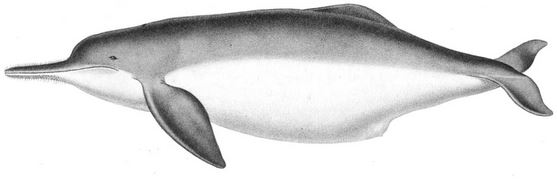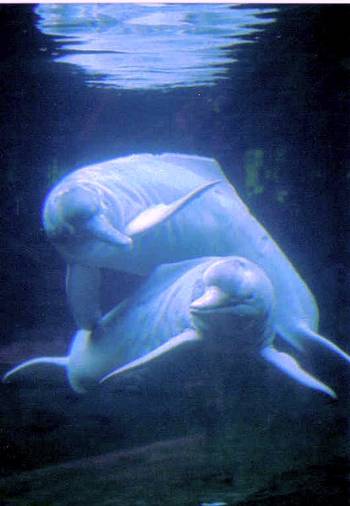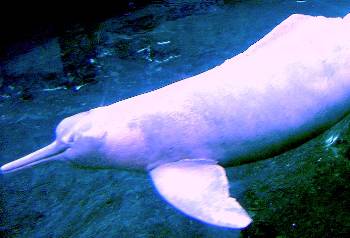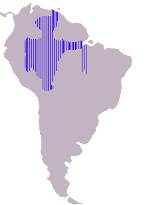Amazon River Dolphin
(Inia geoffrensis)
Online Biology Dictionary

EUGENE M. MCCARTHY, PHD
|
|

|
| Amazon River Dolphin (Inia geoffrensis) Order: Cetacea Image: Stefanie Triltsch |

|
| Inia geoffrensis: The forehead is more prominent than in most other dolphins. Image: Borsi |
The Amazon River Dolphin, or Boto, (Inia geoffrensis) is the largest river dolphin, reaching lengths of 1.7-3.0 m (~5.6-9.8 ft). A native of South America, it occurs only in freshwater. I. geoffrensis is sometimes called the "Pink Dolphin" or "Pink River Dolphin." Some individuals are, in fact, a vivid pink. However, others may be blue-gray or beige. Pink individuals tend to be older and larger.
Anatomy: Unlike most cetaceans, this animal has a flexible neck (see picture, left). It can also change the shape of its head. The forehead is prominent and the beak, long and slender (see figure, below left), and sparsely covered with short, stiff bristles. Each tooth row may hold 24-35 teeth. There is a hump, instead of a dorsal fin, with a ridge extending out from it along the spine in both directions. The blowhole is crescentic. The adult weight is 85-160 kg (~185-350 lbs). A big female may weigh as much 96.5 kg (213 lbs). Newborns weigh about 7 kg (15.4 lbs). The flukes are about 50 cm (~20 in) wide.
Behavior: Like marine dolphins, these river dolphins can often be seen bow-riding or wake-riding. They also breach, rising more than a meter above the water, and often swim upside-down, which may be accounted for by the facts that (1) their cheeks bulge out beneath their eyes; (2) their eyesight is rather poor in any case. In the murky water where they usually reside, they locate their prey more by echolocation — which is extremely sensitive in these animals — than by sight. Their blow can be loud and rise as high as 2 m (6.56 ft), but, as a rule, it's quieter, more like a sigh. Dives last about 30 seconds. During flood season, these inquisitive animals often enter the jungle and can be seen swimming among the trees, an activity that sometimes causes them to get stranded.
Diet: Fish and crustaceans.
Gestation period: 10-11 months.
Longevity: Probably about 30 years; one captive individual lived 18 years.

|
|
Range of I. geoffrensis Map: Coli and Vardion |
Geographic distribution. I. geoffrensis occurs not only in the Amazon basin, as its name suggests, but also in the Orinoco (see map, right), where it was first reported by Alexander von Humboldt. In terms of countries, it is found in the rivers of northern Bolivia, Brazil, Colombia, western Ecuador, northern Guyana, eastern Peru, and Venezuela.
By the same author: Handbook of Avian Hybrids of the World, Oxford University Press (2006).
Most shared on Macroevolution.net:
Human Origins: Are we hybrids?
On the Origins of New Forms of Life
Mammalian Hybrids
Cat-rabbit Hybrids: Fact or fiction?
Famous Biologists
Dog-cow Hybrids
Prothero: A Rebuttal
Branches of Biology
Dog-fox Hybrids